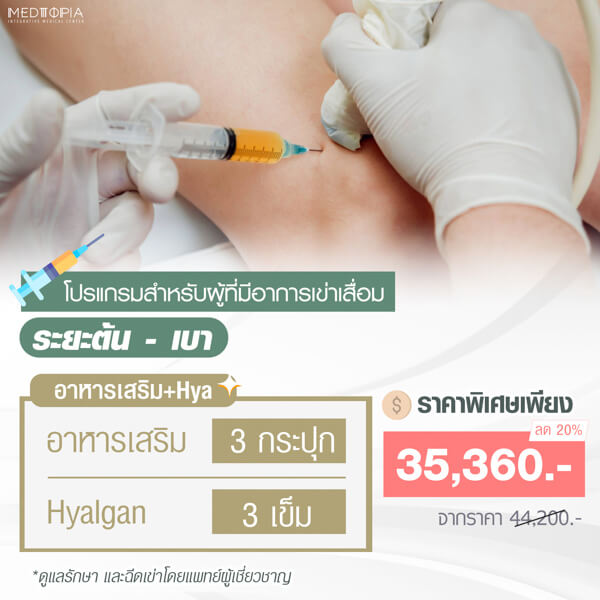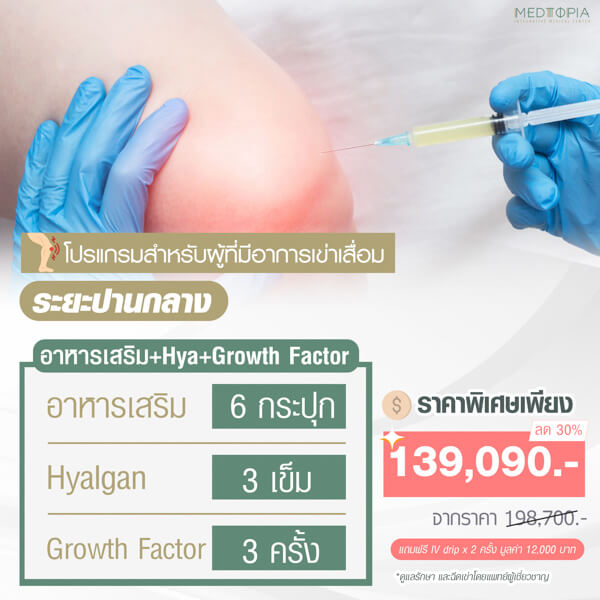Common Misunderstandings about Osteoarthritis
A frequent misconception is that patients with osteoarthritis or knee degeneration often take calcium supplements to strengthen their bones, thinking their knees are hard bone. However, in reality, the knee joint is composed of cartilage, not just hard bone. A joint is formed where two hard bones meet, with cartilage acting as a cushion between the two bones. Cartilage helps support weight, absorb shock instead of the hard bones, and prevents the bones from grinding against each other.
As we age or use our knees improperly, the cartilage gradually wears down. This causes symptoms such as joint grinding, cracking sounds when moving, injury from the bones rubbing against each other, pain, inflammation, and eventually joint swelling and deformity. Osteoarthritis is thus a disease of cartilage degeneration. It does not only occur in elderly people but can happen at a younger age depending on a person’s lifestyle and habits.
Factors such as injury, excess body weight causing the joints to bear more load than they can handle, and inadequate care or exercise also contribute to cartilage wear.
Nowadays, osteoarthritis is being diagnosed at younger ages more frequently. Many people experience symptoms earlier than expected. If left untreated, it can progress to severe osteoarthritis, which may require surgical treatment. Therefore, early care and treatment are crucial.
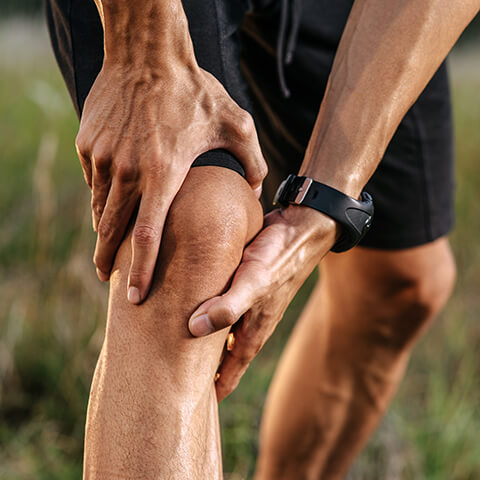
Osteoarthritis of the Knee Can Be Divided into 4 Stages:
1. Early Stage
At this stage, patients may not feel pain yet but can notice stiffness or abnormal sounds from the knee. Movement can be difficult, especially after sitting or kneeling for a long time. The stiffness usually eases after some movement, and normal motion returns. The symptoms are caused by slight cartilage wear and inflammation of the joint lining, but the overall cartilage volume is still good. Patients in this stage may benefit from supplements that help nourish and repair cartilage. If the cartilage heals properly, osteoarthritis symptoms can be reversed.
2. Mild Stage
In addition to cartilage wear, cracks in the cartilage may appear, and the joint space inside the knee may narrow. Patients feel more pain and longer-lasting stiffness. Supplements alone may not be very effective due to cartilage cracks that reduce repair capacity. Injecting lubricating fluid into the joint can reduce friction and pain, like oiling a rusty door hinge. This helps relieve symptoms but does not treat the root cause or stimulate cartilage repair. To effectively stimulate cartilage repair, injections of Growth Factor (which promotes cell repair) can be used to help restore the cracked cartilage.
3. Moderate Stage
If osteoarthritis progresses to this stage, abnormal bone growth (bone spurs) and cartilage loss become evident. The joint space narrows significantly, causing severe bone friction and clear pain. Painkillers or knee supports may be needed to relieve symptoms. Supplements are no longer effective. Lubricating fluid or Growth Factor injections can provide some relief, but because there is little cartilage left, periodic treatments are necessary as prescribed by the doctor. In some cases, cultured cell injections from medical labs can be used to stimulate new cartilage growth and smooth the joint surface. Physical therapy to strengthen the knee is essential to achieve effective treatment.
4. Severe or End-Stage Osteoarthritis
Less than 30% of cartilage remains, and the joint space is nearly or completely closed, limiting knee bending. Patients experience severe pain and difficulty walking, often requiring a walking aid. They cannot kneel, squat, or sit cross-legged, and knee deformities such as bowing become obvious. Some patients may have loose cartilage fragments inside the joint, causing intermittent severe pain. The appropriate treatment at this stage is surgery, which can include arthroscopic cleaning, partial joint surface replacement, or total knee replacement. Orthopedic specialists will recommend the best surgical approach for each patient.
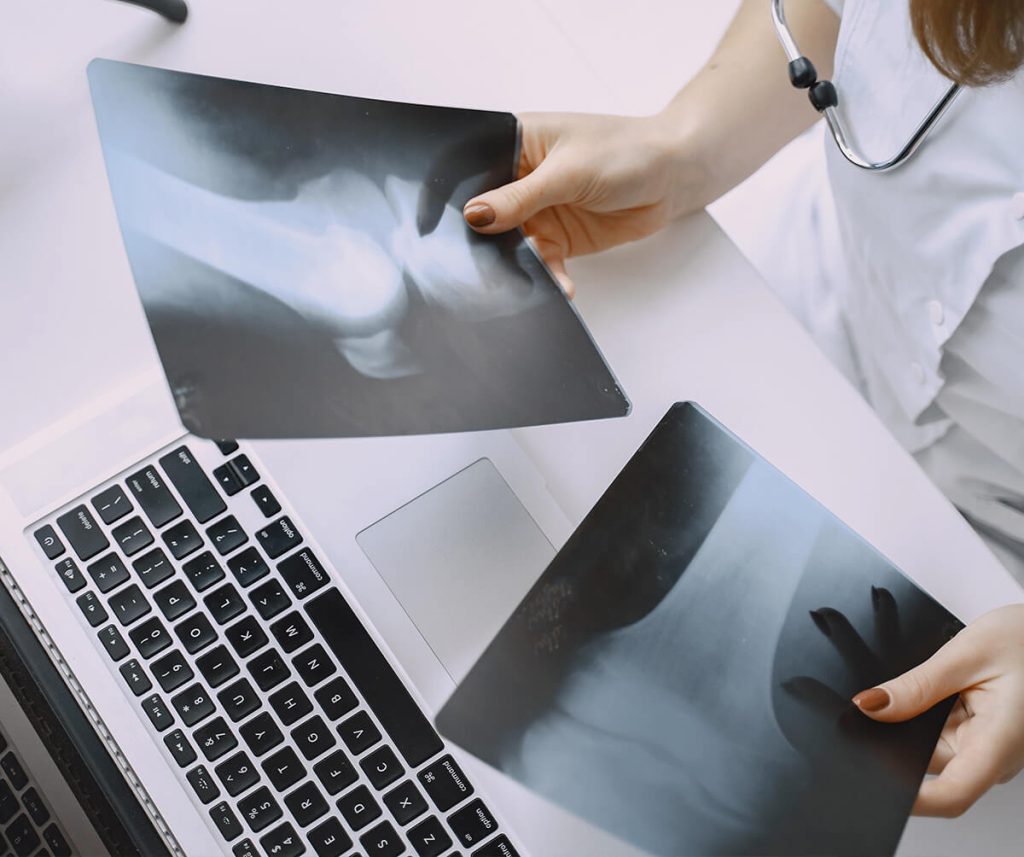
Causes of Osteoarthritis
Osteoarthritis can result from multiple factors:
Genetics:
The joint is mainly composed of cartilage and the joint lining (synovium), both of which contain collagen types II, IX, and XI. If a person has genetic abnormalities affecting these collagen types, they may be more prone to developing osteoarthritis.
Body Weight:
Joints bear the body’s weight and are constantly in motion, especially the knee joints, which support the entire body weight. Excess body weight increases the load on the knees, causing them to work harder than they can handle. This leads to earlier and more frequent onset of osteoarthritis compared to individuals with lower body weight. Moreover, people with higher fat mass have more fat cells that produce inflammatory substances spreading throughout the body, which can accelerate joint inflammation and worsen osteoarthritis symptoms. Therefore, controlling or reducing body weight can help prevent or alleviate osteoarthritis.
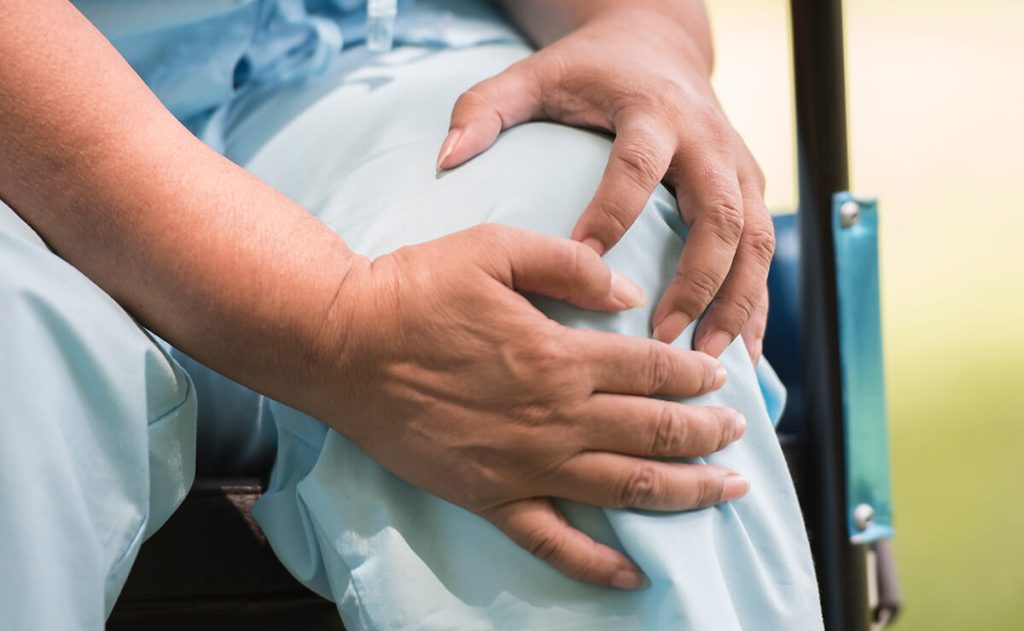
-
Muscle Weakness Around the Knee:
The muscles surrounding the knee joint play a crucial role in supporting body weight. When these muscles weaken, it is like the knee losing some of its assistants. As a result, the knee has to bear more load than usual, which makes it more susceptible to degeneration. Exercising and strengthening the muscles around the knee helps these “assistants” work efficiently, reducing the burden on the knee and increasing its ability to repair itself. -
Injuries from Accidents or Improper Use:
Injuries caused by accidents or improper usage can vary. For example, athletes who have sustained joint injuries, people who have experienced direct trauma to the knee, or those who frequently bend their knees or squat often are more likely to develop osteoarthritis earlier than the general population.
Supports and Preventive Measures for Knee Osteoarthritis
1. Dietary Supplements
Undenatured Collagen Type II
Cartilage and joint capsules are mainly composed of collagen. Human bodies have up to 27 types of collagen, each specific to certain tissues. The main collagen in joints is Type II collagen. Collagen is a protein and can degrade if exposed to heat or chemicals during production. Therefore, choosing undenatured Type II collagen (which is not denatured) is more effective for joint care than regular Type II collagen.
Glucosamine
(Not yet researched)
Chondroitin
(Not yet researched)
Methyl Sulfonyl Methane (MSM)
(Not yet researched)
2. Joint Lubricants or Hyaluronic Acid Injection
This treatment involves injecting hyaluronic acid, a natural component of joint fluid, to lubricate and absorb shock in the cartilage. It helps reduce inflammation, pain, and joint stiffness. It is suitable for patients with early to moderate osteoarthritis. The typical regimen is once a week for 3-5 weeks for noticeable effects.
3. Growth Factors or Platelet-Rich Plasma (PRP) Therapy
Blood consists mainly of plasma, red blood cells, white blood cells, and platelets. Platelets contain growth factors that stimulate tissue repair. Injecting PRP into the knee promotes cell regeneration and reduces inflammation, leading to faster joint repair. PRP is effective, safe, and has few side effects.
However, PRP derived from a patient’s own blood may vary in growth factor concentration, which sometimes results in reduced effectiveness. Nowadays, manufactured growth factor preparations with higher, controlled concentrations are available. These products provide better and more consistent results for mild to moderate osteoarthritis, often requiring about three injections for significant improvement. Mild pain and swelling may occur for up to three days after injection.
4. Laboratory-Cultured Cell Therapy
Growth factors only work if there are sufficient cells to stimulate. In advanced osteoarthritis where cartilage cells or stem cells are nearly depleted, growth factor injections alone are insufficient. Cultured cell therapy involves growing healthy cartilage cells in a lab and injecting them into the knee to replenish and repair damaged tissue.
After cell injection, growth factor therapy can further stimulate these cells, improving joint repair and long-term pain relief. Ongoing knee care, including physical therapy and strengthening exercises, remains essential to maintain cell viability and prevent further damage.
5. Weight Reduction
Body weight is the greatest burden on the knees. Losing 10% of body weight reduces knee load, lessens pressure and friction, and increases joint space, resulting in more comfortable knees.
Patients with osteoarthritis may find exercise difficult due to pain and limited movement. Aquatic exercise, such as swimming or walking in water, helps support body weight and facilitates safe exercise. Hormonal adjustments to boost fat metabolism and reduce fat and sugar accumulation can also help with effective and safe weight loss.
6. Knee Braces or Supportive Devices
Knee braces act like additional muscles, providing support and stabilizing the joint. They help reduce stress on the knee and limit harmful movements. For effectiveness, braces must fit snugly but not too tight, be worn correctly, and mainly during heavy knee use (e.g., standing or walking, especially in the afternoon). They should be removed during rest to allow muscles to work and avoid weakening.
7. Knee Strengthening Exercises
Strengthening muscles around the knee can be done by sitting on a chair with your back against a wall, straightening your leg, and lifting the thigh slightly off the chair. Hold the position as long as possible (ideally up to 60 seconds), then lower the leg slowly. Alternate legs, doing 10-15 repetitions per leg, 4 times a day (morning, noon, evening, and before bed). Once proficient, ankle weights can be added to increase difficulty.
8. Physical Therapy
Knee physical therapy includes stretching, joint mobilization, ultrasound therapy to stimulate tissue repair, laser treatment, shortwave deep heat therapy, and electrical stimulation. These methods help reduce inflammation and accelerate joint healing.
9. Avoid Activities that Cause Knee Injury or Excessive Pressure
Avoid behaviors such as sitting cross-legged, squatting for long periods, and walking downstairs, as they increase knee strain. Walking upstairs is recommended as it helps strengthen the knee, but use elevators to go down stairs instead to reduce joint stress.
Recommended Program for Early-Stage Mild Knee Osteoarthritis |
|
|---|---|
| Item | Price |
| Joint Support Supplement (3 bottles) | 4,500 THB |
| Hyalgan Knee Lubricant Injection (3 doses) | 10,000 TH |
| Ready-to-use Growth Factor Injection (3 sessions) | 29,700 THB |
| Total Full Price | 44,200 THB |
| Special Package Price |
35,360 THB (20% off)
|
Treatment and knee injections are provided by orthopedic specialists.
|
Recommended Program for Patients with Moderate Knee Osteoarthritis |
|
|---|---|
| Item | Price |
| Joint Support Knee Supplement, 6 jars | 9,000 THB |
| Hyalgan Knee Lubrication Injection, 3 shots | 10,000 THB |
| Ready-made Growth Factor Injection, 3 times | 29,700 THB |
| MSCs Cultured Cell Injection, 1 time | 150,000 THB |
| Total Price | 198,700 THB |
| Special Package Price | 139,090 THB (30% off) |
Free 2 sessions of IV drip (valued at 12,000 THB)
Treatment and knee injections are provided by orthopedic specialists.
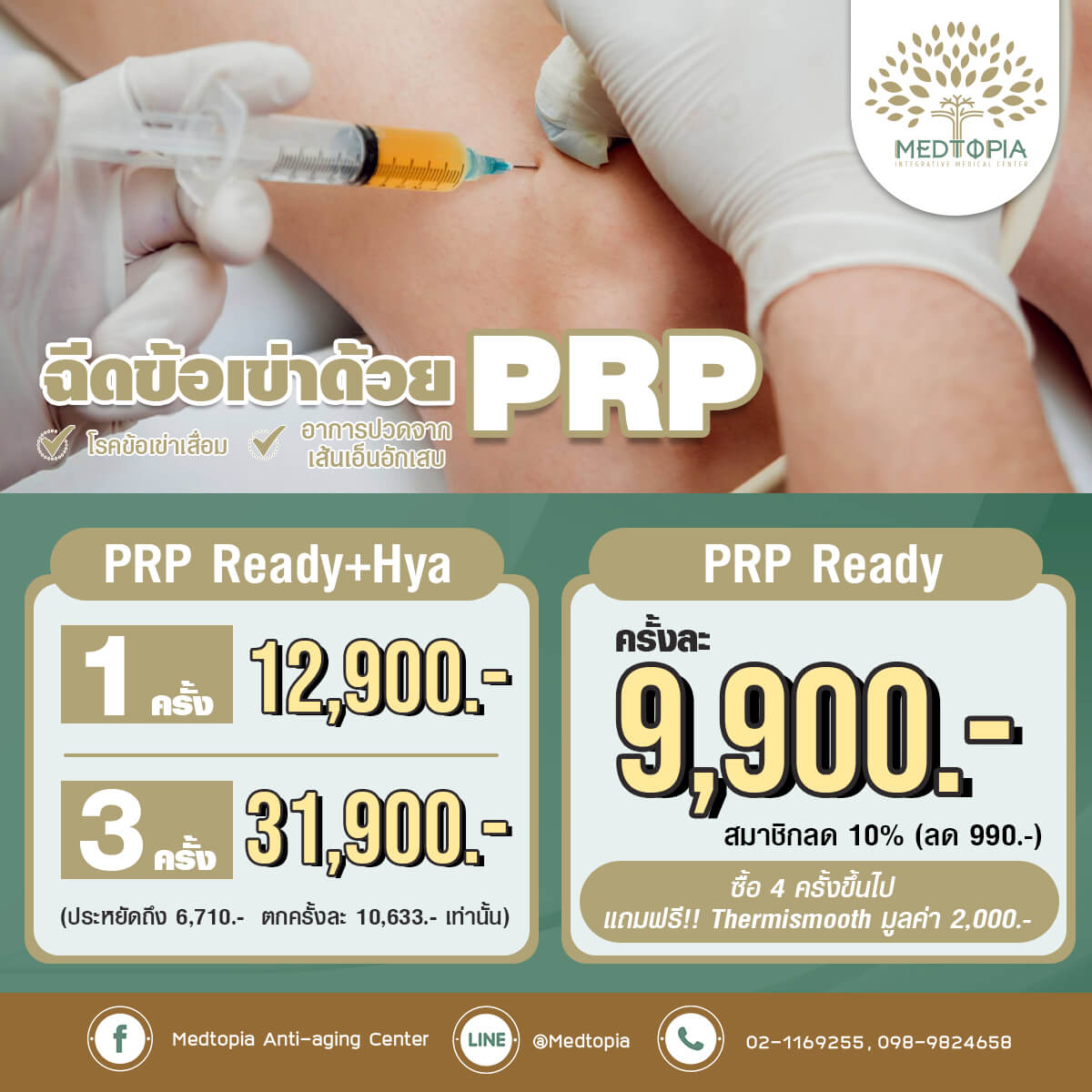

 ไทย
ไทย
















